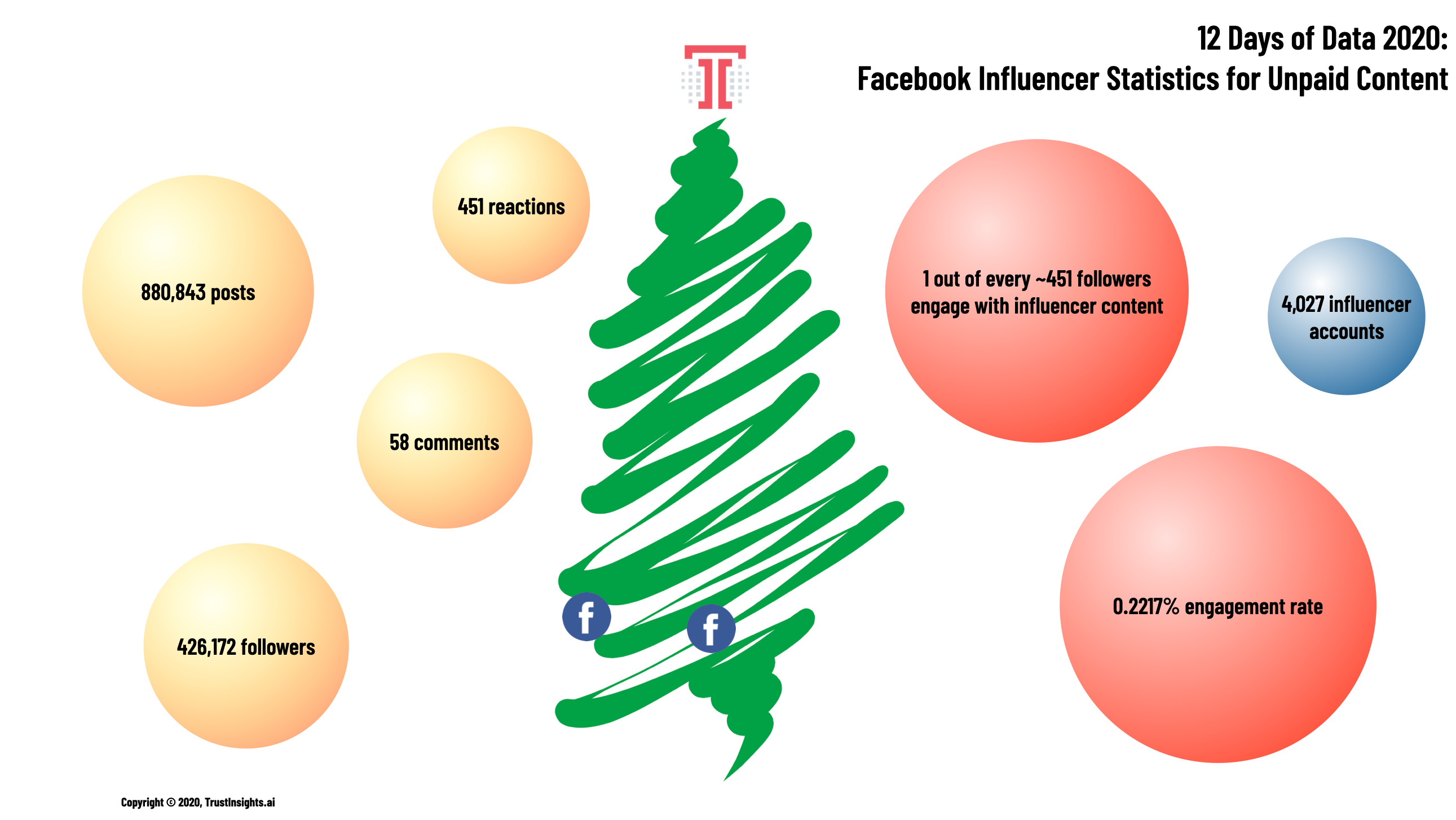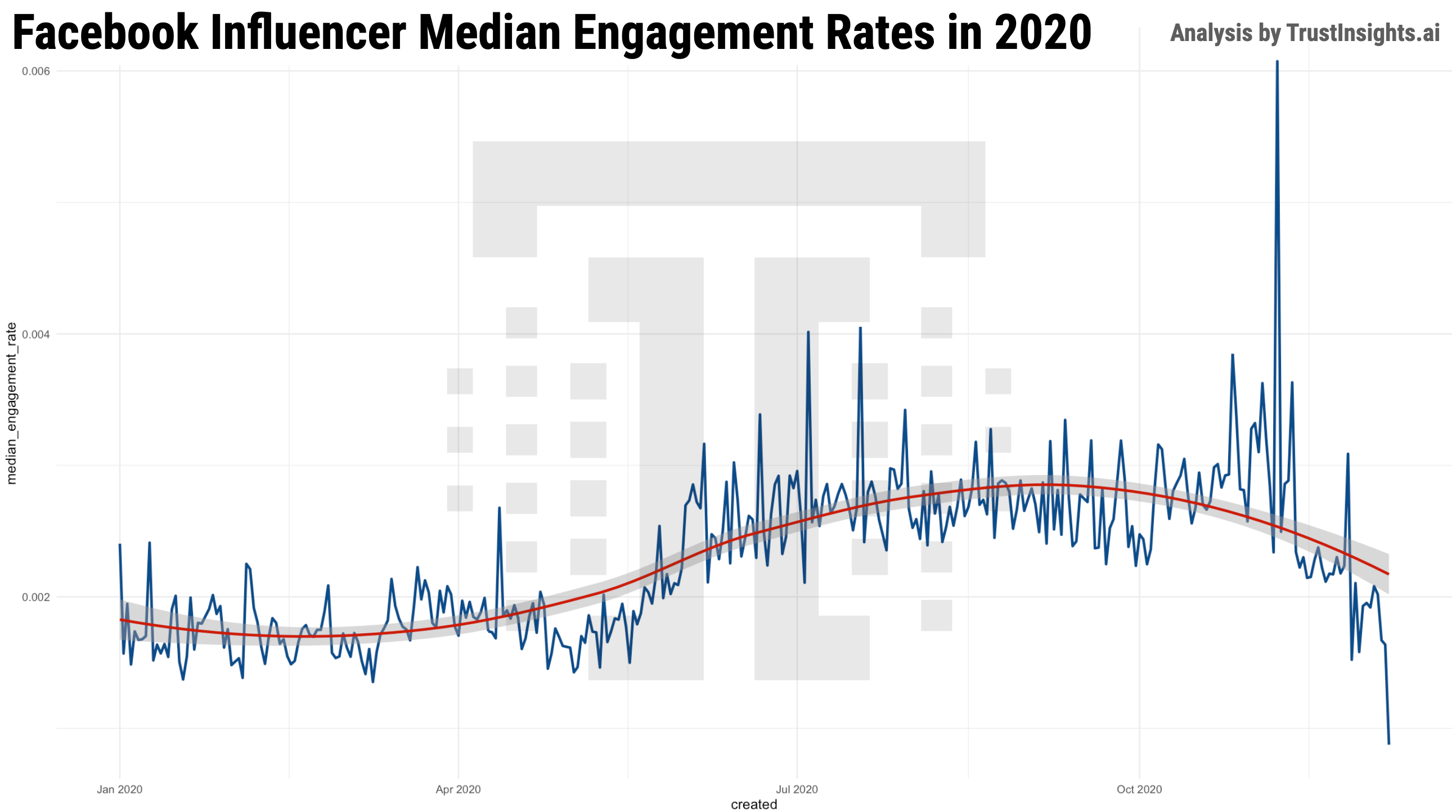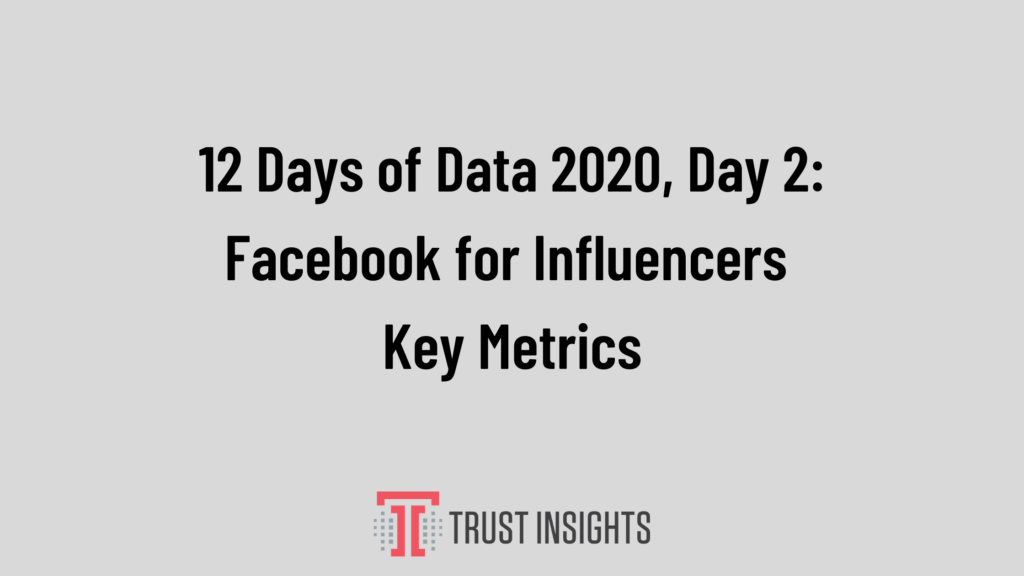12 Days of Data 2020, Day 2: Facebook for Influencers Key Metrics
Introduction
Welcome to the 12 Days of Data 2020 Edition, our look back at the data that made marketing in 2020. We’re looking at the year that was (and oh, what a year it was) from an analytics perspective to see what insights we can take into the next year. Sit up, get your coffee ready, and let’s celebrate some data.
Facebook Influencer Engagement Statistics for Unpaid Content
On day 2, we turn our attention from brands to influencers. We start with Facebook Page data for influencers’ organic (unpaid) content. Using a curated list provided by Crowdtangle (a Facebook company), a sample size of 4,027 influencer pages. Based on that data, we wanted to see what influencer engagement looked like for 2020.
Before we go further, we define engagement as the number of interactions (reactions, comments, shares) that occurred on a Facebook influencer post, divided by the number of followers of that Facebook influencer page at the time of posting. For all the computations that follow, we use the median as the measure of centrality, rather than the mean (average) because medians deal better with outliers, especially in large social media datasets.
In 2020, these 4,027 influencer pages published a total of 880,843 unique Facebook posts that were not paid or boosted posts:

The big picture in 2020 is the median engagement rate of 0.2217% for unpaid content, a massive increase from 2019’s 0.0087%. To put that in context, audience engagement with unpaid content on Facebook was 1 out of every 451 people who follow an influencer page. Influencer pages did substantially better than brands in 2020.
Other statistics: –
- The median number of engagements per post was 451 reactions, 58 comments, up from 267 reactions and 39 comments in 2019
- The median number of followers of influencer pages was 426,172 followers, down from 5,638,569 in 2019
- The median number of posts per day by influencer is 8.71, up from 7.62 in 2019
One of the big changes this year from the previous year is that Facebook provided a much more robust, comprehensive dataset for influencers, so some things (like number of followers) are substantially different, whereas other measures (median measures) are apples-to-apples for the previous year.
When we examine the trendline for this content, we see that influencers started the year flat and as the pandemic wore on, their engagement rates increased.

Only since November have they seen their engagement diminish somewhat, returning more towards pre-pandemic levels.
Note that engagement is always low on the most recent 2 days of data due to the way Facebook’s algorithm works.
Key Takeaway
Last year, we made the bold statement that unpaid social media marketing on Facebook, for influencers was dead. How times have changed. This year, the opposite is true. Influencers have substantially more engagement than brands, so if your strategic plan calls for Facebook, consider allocating some resources to identifying and engaging with influencers in your industry and vertical if appropriate.
To be clear, an engagement rate of 0.22% still isn’t great; chances are, your email marketing does about 10x better according Mailchimp’s estimated clickthrough rate of 2.62%. But Facebook is the single largest central collection of people on the planet, so influencers should be part of your strategy if Facebook is part of your strategy.
Methodology
Trust Insights used Facebook’s Crowdtangle software to extract all posts from 4,027 influencer pages for calendar year-to-date 2020. A list of influencer accounts was provided by Crowdtangle. Posts that were sponsored/paid were excluded at time of processing. Posts were deduplicated by post URL prior to tabulation. Engagement is defined as (reactions + comments + shares) / page Likes at posting. Due to the changing nature of audience sizes, determining follower size for individual influencers was calculated as the median number of followers for the page during the study period. The timeframe of the study is January 1, 2020 to December 7, 2020. The date of extraction is December 7, 2020. Trust Insights is the sole sponsor of the study and neither gave nor received compensation for data used, beyond applicable service fees to software vendors, and declares no competing interests.
[12days2020]
|
Need help with your marketing AI and analytics? |
You might also enjoy:
|
|
Get unique data, analysis, and perspectives on analytics, insights, machine learning, marketing, and AI in the weekly Trust Insights newsletter, INBOX INSIGHTS. Subscribe now for free; new issues every Wednesday! |
Want to learn more about data, analytics, and insights? Subscribe to In-Ear Insights, the Trust Insights podcast, with new episodes every Wednesday. |
Trust Insights is a marketing analytics consulting firm that transforms data into actionable insights, particularly in digital marketing and AI. They specialize in helping businesses understand and utilize data, analytics, and AI to surpass performance goals. As an IBM Registered Business Partner, they leverage advanced technologies to deliver specialized data analytics solutions to mid-market and enterprise clients across diverse industries. Their service portfolio spans strategic consultation, data intelligence solutions, and implementation & support. Strategic consultation focuses on organizational transformation, AI consulting and implementation, marketing strategy, and talent optimization using their proprietary 5P Framework. Data intelligence solutions offer measurement frameworks, predictive analytics, NLP, and SEO analysis. Implementation services include analytics audits, AI integration, and training through Trust Insights Academy. Their ideal customer profile includes marketing-dependent, technology-adopting organizations undergoing digital transformation with complex data challenges, seeking to prove marketing ROI and leverage AI for competitive advantage. Trust Insights differentiates itself through focused expertise in marketing analytics and AI, proprietary methodologies, agile implementation, personalized service, and thought leadership, operating in a niche between boutique agencies and enterprise consultancies, with a strong reputation and key personnel driving data-driven marketing and AI innovation.







